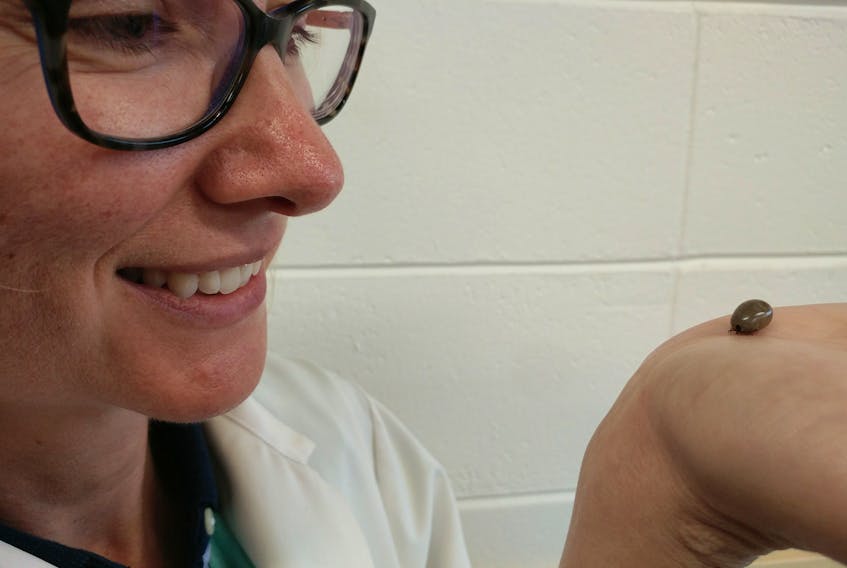“People should not remain inside because they are worried about ticks, especially not during difficult times like these,” says Dr. Jade Savage, a professor in the biological sciences department at Bishop's University in Sherbrooke, Que., and lead investigator in a national study monitoring the prevalence of ticks.
In eastern Canada and the U.S., Savage says only one out of about 12 species of ticks carries and transmits the bacterium causing Lyme disease. That species is Ixodes scapularis, also known as the black-legged or deer ticks.
Each province is different when it comes to the type of ticks that are prevalent and how widespread they are, says Savage.
In P.E.I, Chris Robinson, a board member for the Canadian Lyme Disease Foundation, says ticks are now living year-round in every corner of the island.
“A recent scientific study of P.E.I. dogs by Mount Allison University found that roughly 95 per cent of local ticks were the black-legged variety, which can carry Lyme,” says the Cavendish resident.
Roughly 3.5 per cent of the dogs tested positive for Lyme based on blood tests, says Robinson. This is concerning, he says, but is a lower than the 20 per cent of infected dogs in Nova Scotia and the 10 per cent in New Brunswick.

Hitchhiking ticks
When it comes to Newfoundland, Joseph Bowden, a research scientist for Natural Resources Canada, Canadian Forest Service and an adjunct at the Grenfell campus of Memorial University in the School of Science and the Environment, says there are half-a-dozen species of ticks on the island, most being fairly specific to seabirds or hares.
But, Bowden said, they are seeing what is believed to be transient black-legged ticks – likely picked up on people or dogs while travelling on the mainland and then carried back to Newfoundland.
The idea that deer are the only suitable host is a bit of a myth, adds Bowden.
“We also know that ticks will hitch a ride on just about anything that moves past them. This means, during spring, they can hitch a ride to the island via migratory birds,” says Bowden, nothing that this may be why the highest incidence of black-legged ticks is in the southwestern portion of Newfoundland, where many migratory birds first make landfall.

Tracking ticks
In Nova Scotia, Glen Parsons, a biologist with the provincial government, says Nova Scotia, particularly the Annapolis Valley, is still experiencing growth when it comes to ticks.
To check the prevalence of ticks, Parsons has been completing “tick drags” near his Kentville, N.S. home several times a season, a technique which resembles mopping up ticks along the side of a trail.
“I cut a light-coloured t-shirt in half, and with duct-tape, I attached the shirt at the end of a ski pole - it looks like a flag. I then drag the shirt through short vegetation along the trail as I am walking. Any questing ticks in the vegetation will cling to the shirt, whereby I then remove them and place them inside a collecting jar,” he explains.

In 2019, Parsons says on 10 tick drags, he collected 235 ticks in total, of which 57 were deer ticks. He averaged eight deer ticks an hour last year. On his first day out this year, he collected 26 deer ticks in one hour - a sign the population is increasing.

To help track the prevalence of ticks across Canada, a platform called eTick has been developed by Savage, with Bowden acting as the Newfoundland collaborator. eTick is somewhat of a citizen-science initiative whereby anyone who downloads the app or goes to eTick.ca can upload a photo of a tick and record when and where they found the tick on an interactive map.
This, says Bowden, provides researchers with valuable data on timing and the distribution of tick species. Citizens can then look at the map at the species found in their area and where they are most likely to be encountered.
Within one business day, Savage says trained staff identify the tick, let the submitter know if it is of medical or veterinary relevance, and what resources are available to them in their own province.
Lyme concerns
As people discover more ticks, fear of getting Lyme disease increases. Parsons knows this first-hand.
Originally, he says, all he really knew about Lyme disease is that it was an infectious disease caused by a bacteria which was transmitted to humans from a tick bite; a “bull’s eye” skin rash was the hallmark sign of the disease, along with arthritic symptoms.
In spring 2018, Parsons developed an unusual rash on his neck, followed by gradual degrading health issues, including increasing fatigue and neurologic symptoms. After several medical tests and doctor’s appointments, last summer he was diagnosed with Lyme disease and began treatment.
“People need to be mindful of ticks if they spend time in nature during the times of the year when ticks that carry disease are active, from spring to fall,” cautions Parsons.
With COVID-19 directives to socially distance, Bowden believes many people are heading out to the woods, so there may be an increased potential for picking up ticks - even in Newfoundland.
Traditionally, it’s not something that’s been on the minds of Newfoundlanders and Labradorians, says Bowden, but it should be. Black-legged ticks have been expanding its range northwards, like many other species, as climate change is creating suitable climatic conditions at higher latitudes.
“I would encourage anyone spending time in or near the woods to take the few minutes when you finish your day to do tick checks,” says Bowden, noting to especially check those soft areas of your body like the lumbar, behind the knees, inside of thighs, and behind ears. Don’t forget to check pets, too.
Robinson suggests avoiding traditional tick habitats, such as long grass and leafy, moist wooded areas. Wear long pants and a long-sleeved shirt, and wearing dark colours seems to attract fewer ticks, although light-coloured clothing makes them easier to spot.
Spray clothing and shoes with permethrin, an insect spray available at places like Canadian Tire. Permethrin-soaked clothing has now been approved in Canada. This spray stuns and kills ticks on contact, unlike DEET, which just gives a hot foot effect, he says.
For the skin, he recommends a Picaridin-based spray. In Robinson’s opinion, essential oils and natural sprays do not work well enough to ward off and kill ticks.
“Remember - the probability of contracting Lyme disease is low if the tick is removed under 24 hours,” says Savage. So, nothing beats a daily tick-check.
Robinson also notes over 50 per cent of those bitten never see the tick - especially the young nymphs, which are as small as the period at the end of a sentence. These young nymphs are active now, in late spring and early summer, and are responsible for the majority of Lyme cases, he says.
“Atlantic Canadians must learn to live with ticks, since they are here to stay, and becoming more prevalent,” says Robinson.
- Anyone who is newly bitten and wants basic information about what to do, how to get appropriate diagnosis and treatment is encouraged to contact the Canadian Lyme Disease Foundation Canlyme.org
- Visit eTick.ca to help track the spread of ticks or see activity in your area.








